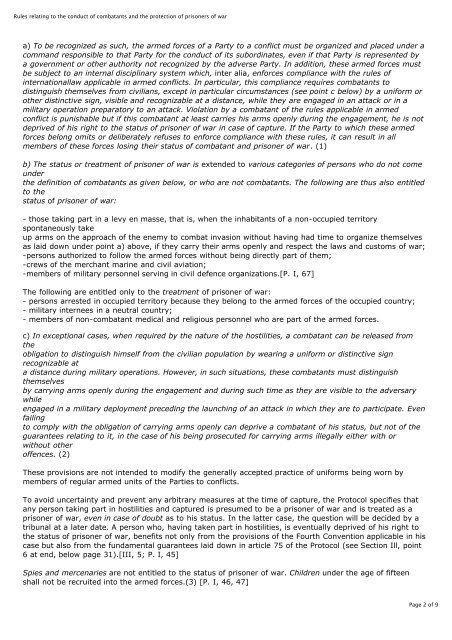The Law of War
The Law of War
The Law of War
Create successful ePaper yourself
Turn your PDF publications into a flip-book with our unique Google optimized e-Paper software.
Rules relating to the conduct <strong>of</strong> combatants and the protection <strong>of</strong> prisoners <strong>of</strong> war<br />
a) To be recognized as such, the armed forces <strong>of</strong> a Party to a conflict must be organized and placed under a<br />
command responsible to that Party for the conduct <strong>of</strong> its subordinates, even if that Party is represented by<br />
a government or other authority not recognized by the adverse Party. In addition, these armed forces must<br />
be subject to an internal disciplinary system which, inter alia, enforces compliance with the rules <strong>of</strong><br />
internationallaw applicable in armed conflicts. In particular, this compliance requires combatants to<br />
distinguish themselves from civilians, except in particular circumstances (see point c below) by a uniform or<br />
other distinctive sign, visible and recognizable at a distance, while they are engaged in an attack or in a<br />
military operation preparatory to an attack. Violation by a combatant <strong>of</strong> the rules applicable in armed<br />
conflict is punishable but if this combatant at least carries his arms openly during the engagement, he is not<br />
deprived <strong>of</strong> his right to the status <strong>of</strong> prisoner <strong>of</strong> war in case <strong>of</strong> capture. If the Party to which these armed<br />
forces belong omits or deliberately refuses to enforce compliance with these rules, it can result in all<br />
members <strong>of</strong> these forces losing their status <strong>of</strong> combatant and prisoner <strong>of</strong> war. (1)<br />
b) <strong>The</strong> status or treatment <strong>of</strong> prisoner <strong>of</strong> war is extended to various categories <strong>of</strong> persons who do not come<br />
under<br />
the definition <strong>of</strong> combatants as given below, or who are not combatants. <strong>The</strong> following are thus also entitled<br />
to the<br />
status <strong>of</strong> prisoner <strong>of</strong> war:<br />
- those taking part in a levy en masse, that is, when the inhabitants <strong>of</strong> a non-occupied territory<br />
spontaneously take<br />
up arms on the approach <strong>of</strong> the enemy to combat invasion without having had time to organize themselves<br />
as laid down under point a) above, if they carry their arms openly and respect the laws and customs <strong>of</strong> war;<br />
-persons authorized to follow the armed forces without being directly part <strong>of</strong> them;<br />
-crews <strong>of</strong> the merchant marine and civil aviation;<br />
-members <strong>of</strong> military personnel serving in civil defence organizations.[P. I, 67]<br />
<strong>The</strong> following are entitled only to the treatment <strong>of</strong> prisoner <strong>of</strong> war:<br />
- persons arrested in occupied territory because they belong to the armed forces <strong>of</strong> the occupied country;<br />
- military internees in a neutral country;<br />
- members <strong>of</strong> non-combatant medical and religious personnel who are part <strong>of</strong> the armed forces.<br />
c) In exceptional cases, when required by the nature <strong>of</strong> the hostilities, a combatant can be released from<br />
the<br />
obligation to distinguish himself from the civilian population by wearing a uniform or distinctive sign<br />
recognizable at<br />
a distance during military operations. However, in such situations, these combatants must distinguish<br />
themselves<br />
by carrying arms openly during the engagement and during such time as they are visible to the adversary<br />
while<br />
engaged in a military deployment preceding the launching <strong>of</strong> an attack in which they are to participate. Even<br />
failing<br />
to comply with the obligation <strong>of</strong> carrying arms openly can deprive a combatant <strong>of</strong> his status, but not <strong>of</strong> the<br />
guarantees relating to it, in the case <strong>of</strong> his being prosecuted for carrying arms illegally either with or<br />
without other<br />
<strong>of</strong>fences. (2)<br />
<strong>The</strong>se provisions are not intended to modify the generally accepted practice <strong>of</strong> uniforms being worn by<br />
members <strong>of</strong> regular armed units <strong>of</strong> the Parties to conflicts.<br />
To avoid uncertainty and prevent any arbitrary measures at the time <strong>of</strong> capture, the Protocol specifies that<br />
any person taking part in hostilities and captured is presumed to be a prisoner <strong>of</strong> war and is treated as a<br />
prisoner <strong>of</strong> war, even in case <strong>of</strong> doubt as to his status. In the latter case, the question will be decided by a<br />
tribunal at a later date. A person who, having taken part in hostilities, is eventually deprived <strong>of</strong> his right to<br />
the status <strong>of</strong> prisoner <strong>of</strong> war, benefits not only from the provisions <strong>of</strong> the Fourth Convention applicable in his<br />
case but also from the fundamental guarantees laid down in article 75 <strong>of</strong> the Protocol (see Section Ill, point<br />
6 at end, below page 31).[III, 5; P. I, 45]<br />
Spies and mercenaries are not entitled to the status <strong>of</strong> prisoner <strong>of</strong> war. Children under the age <strong>of</strong> fifteen<br />
shall not be recruited into the armed forces.(3) [P. I, 46, 47]<br />
Page 2 <strong>of</strong> 9

















